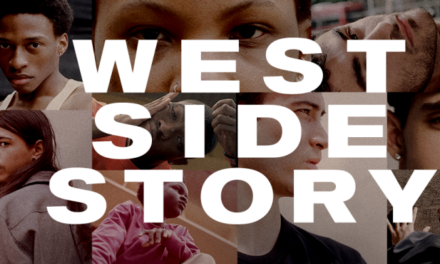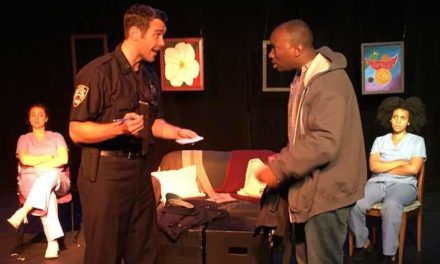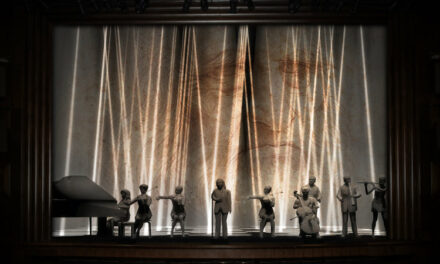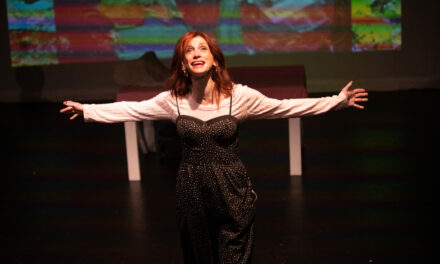Writing Using is the most recent work by Ahn Aesoon, one of the most renowned contemporary dancers and choreographers in South Korea. She served as the artistic director of the Korea National Contemporary Dance Company from 2013 to 2016 and choreographed pieces that integrate Korean and oriental aesthetics with contemporary dance such as Bulssang, Already Not Yet, and Zero One Dimension.
After its premiere at Seoul Arts Center’s CJ Towol Theatre in April 2022, Writing Using was revived in the same space from July 27 to 30, 2023. The piece is a contemporary dance piece focusing on the use of the body in its various relationships with itself, with other bodies, with the space, and with other sensory and theatrical elements such as sound and light. The Korean title 몸쓰다, pronounced “Mohm Sseuda,” can have various interpretations. The combination of “mohm” (“body”) and “sseuda” (“writing,” “using”) can be read as “using the body,” “writing the body,” “the body is using,” and “the body is writing.” These various interpretations invite the questions “Who/what is using or writing the body?” and “What is the body writing or using?” These questions lie at the center of this piece, popping out in various stages through the piece. In this respect, the deliberate absence of the term “body” in the English title “Writing Using” embraces the body as both the subject and object and puts emphasis on the act that the body is doing or that is done to the body. The body, therefore, becomes more present in the title “Writing Using” through its absence.

Writing Using. Photo: KNCDC ⓒAiden Hwang
The stage of the CJ Towol Theatre is reminiscent of a small opera stage, with its depth and breadth, and the auditorium has about 1,000 seats. At the beginning, the stage is completely dark. As the light slowly comes on, bare grey stage walls appear. A buzzing sound fills the room, like machinery in a factory. A small black object that looks like a duck moves downstage and centers itself. (This turns out to be a lighting instrument). Performers enter, one by one, totaling ten. Some are dressed in white, some in primary colors. They move individually, with everyday gestures such as looking at their tablets and touching the screen, getting dressed, or walking around as if exploring the space. They clap their hands and bodies and stomp the floor, which gradually fill the whole soundscape. Soon they all collapse. A series of percussion beats are layered in succession, which sound both like a heartbeat and like an industrial factory sound. The performers dance individually to the beats, which now evoke a trip hop sound. They stop together and resume dancing and repeat this pattern a few times. Their movements become more kinetic and convulsive each time they resume them. Soon the stage pallet on which the performers were dancing moves upstage, with the performers still on it. Along comes the realization that it is not just the performers but also the stage itself that moves in this space.
From the first scene, Writing Using poses several pertinent questions and provides clues about what might follow. While the performers move individually and are dressed distinctly, they appear small, anonymous, and nondistinctive on the grand stage. Questions about the relationship between the performers and the stage, the humans and the environment, immediately occur. How is the space affecting the performers? While they seem indifferent to the environment in the beginning, checking their phones, etc., soon something is triggered in them. With the increasing sounds, both human and instrumental, the space feels suddenly oppressive, and the increasingly convulsive movements seem to reflect the humans’ desperate need to break out of their habits, patterns, and complacency. It looks like the space then might be dominant over the humans. However, at the same time, some kind of a harmony is also established, as the human sounds and industrial instrumental sounds overlap with one another and, eventually, the stage moves as well. Some other questions occur. How will the relationship between the performers and the stage evolve? Where will the humans’ striving lead, and how will it be expressed with the bodies in this space?

Writing Using. Photo: KNCDC ⓒAiden Hwang
The next scene offers more questions and clues. With the performers lying down upstage, a long bar that hangs the lights comes down, almost touching the stage. The bar goes up and down a few times, without any interaction with the humans. So does the stage has a life of its own? Can its movements only be vertical, lateral, or angular, like factory machineries? While these questions linger, a solo performer jerks around the stage, looking painful. He tries to walk but cannot. When he falls, he tries to get up but cannot. Is he trying to break away from the shackles of an industrialized society? Soon he is joined by the other humans, who roll and crawl towards him one by one. They sit together, with a soundscape resembling a thumping heartbeat. This moment brought to mind a womb, where a new life has just been created and is about to be born (or reborn). Soon the humans break into various kinds of versatile dance moves, including break dance, wave, and pop and lock, and the sound overwhelms the stage with its heavy layered beats. The humans pile on one another and seem to form one organic being. Does this signify that they need each other to be reborn, or that their bodies need to connect? The humans coming together felt poignant and even triumphant, especially considering the struggle of the solo performer earlier in the scene. The familiarity of the movements added to the feeling that the humans advanced to a new stage.

Writing Using. Photo: KNCDC ⓒAiden Hwang
The progression of the piece is not completely linear or in clearly divided stages. There is constant movement, whether by the performers or the stage or even the changing soundscape. The piece as a whole never stops to stimulate the spectator’s senses and engage their brain, raising questions about the evolving relationships between the stage and the performers and also among the performers themselves. While it may look like not every element seems to have a clear rational reason behind it, put together they form a theatrical collage that places more emphasis on the physical and the sensory than the rational. It takes some time, at least several scenes, to get used to the particular rhythm and rules of this piece. Yet the various iterations of theatricality raise the expectation for the experience ahead.
Midway through the piece, a significant shift happens in terms of the texture of the piece. The sound, which so far consisted primarily of beats, acquires some melody with string instruments. The lighting, which stayed non-colorful so far, projects some colors. A big wooden empty frame comes down center stage from the ceiling, the first prop in a recognizable form. The frame completely changes the dynamic among the performers. Now they form a relationship with one another. Within the frame, their relationship becomes more intimate. For example, two performers kiss in the frame, and soon a waltzy piano melody is played. The performers are now more human and adult and interact with one another as social beings.

Writing Using. Photo: KNCDC ⓒAiden Hwang
Everything seems peaceful and pleasant, at least for a while. However, the anticipation for harmony is soon disrupted, when the stage is cleared of the frame and the performers. This time, the performers vocalize for the first time, in the form of shrieks, cries, coughs, gasps, and choking sounds, probably the very first bodily memory. The layered and increasingly noisy vocalization continues for a while and generates a visceral effect. The performers also cry like babies and throw tantrums. It felt as if they were born again and were learning to breathe for the first time. And then that stops, too.
The piece reaches its climax that, with the help of a rising set piece and lighting effect, makes it look like a performer is floating in the air. It dawned on me that maybe whatever the humans were trying to break away from so far includes gravity. And possibly, in order to defy gravity, they needed to repeat a cycle of reincarnation and the painful process of learning what is essential to live, including breathing. But does the elevation signify a liberation they have been trying to achieve? The answer remains ambivalent, as the performer eventually descends, and a colorful beam surrounds him.

Writing Using. Photo: KNCDC ⓒAiden Hwang
The many questions that were raised during the performance linger even after the curtain call, and the answers have yet to come. Or maybe they never will. But that is okay. The overall experience is nonetheless rewarding for the multi-layered rich texture of theatricality that filled the space – the bodies, costumes, set pieces, lights, and sounds. Perhaps this piece tries to capture what it feels like to exist in one’s body in a world that is too big to comprehend (the stage), that is filled with other kinds of beings (other bodies, set pieces, lights, sounds), that may frame the body’s experience, and that may let the body exist in peace or may be an obstacle. The body can only comprehend how to navigate this terrain by constantly moving, responding to its own instincts, needs, and desires as well as outside stimulants. Writing Using seems to suggest that we should not stop our physical movement in order to explore these various questions but keep moving. Maybe some answers will come in the middle of a movement, filling our life with color and melody.
Credits:
Choreographer: Ahn Aesoon
Assistant Choreographer: Han Sang-Ryul
Dramaturg: Kim Jiyon
Performance Coach: Jang He Jin
Music Composer, Sound Designer: Pi Junghoon
Stage Designer: Kim Jongseok
Costume Designer: Cho Yurim
Lighting Designer: Fujimoto Takayuki
Production Stage Manager: Jo Eunjin
Dancers: Kang Jinan, Choi Minsun, Kang Hojung, Jung Jaewoo, Park Seonhwa, Park Yura, Kim Dohyun, Jeong Jongung, Lee Hyeonseok, Doh Yunseung
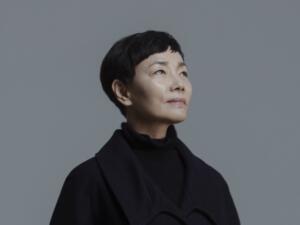
Ahn Aesoon
Ahn Aesoon, a renowned Korean contemporary dancer and choreographer, has attempted to embody Korean identity and contemporaneity through her work. Based on Korean tradition and oriental view of aesthetics, she has been committed to creating and experimenting with contemporary dance in diverse ways. Ahn has also shown an outstanding ability to interpret and express dance from a contemporary perspective through observation and exploration of Korean beauty in her choreography. Furthermore, she has integrated an oriental playfulness into a specific concept of ‘play’ and has actively reflected it in her pieces on the basis of research on Korean movement while escaping from the existing Western technique and movement. Having developed into her own creative artistic view and methodology, such aspects became the foundation for shaping her unique world of dance. Ahn is recognized by critics as a choreographer, who succeeded in building her own distinct world of dance, for her unique style of choreography reflecting Korean sentiments, an excellent ability to organize space, an eye for selecting themes with sophisticated sense and insight, a concentration which fully draws individuality and functionality from dancers, as well as challenging and successful collaborations with various artists.
(Bio from
This post was written by the author in their personal capacity.The opinions expressed in this article are the author’s own and do not reflect the view of The Theatre Times, their staff or collaborators.
This post was written by Walter Byongsok Chon.
The views expressed here belong to the author and do not necessarily reflect our views and opinions.


